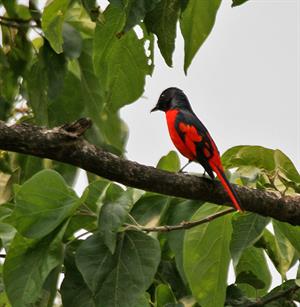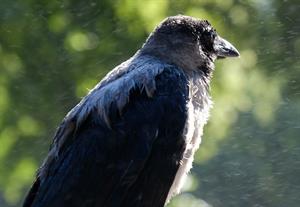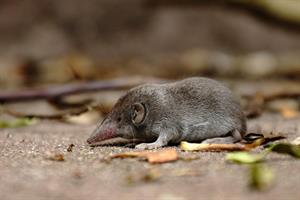
PUMPA - SMART LEARNING
எங்கள் ஆசிரியர்களுடன் 1-ஆன்-1 ஆலோசனை நேரத்தைப் பெறுங்கள். டாப்பர் ஆவதற்கு நாங்கள் பயிற்சி அளிப்போம்
Book Free DemoThe lesson gives us a glimpse into the diary of Ruskin Bond. The first day being talked about was June \(24\). It was the time around which the monsoon started, and the mist had wrapped the hills in silence.

Mist wrapped the hills
As written, June \(24\) was the first day when the mist appeared. The author called it “strange”. Because all the birds suddenly went silent as a cloud of tiny water, droplets climbed up the hill.
The author claims the mist to be melancholic in nature for two reasons. First, it covers up the mountains and hides the serene view. Second, it silences the birds, thereby bringing sadness.

Melancholic view
An hour before the mist appeared, the trees were ringing with birdsong. But later, it became so still and silent. The author called the forest “deathly” as he felt that it was almost midnight, and the forest was wrapped in utter silence.
The author could hear Bijju calling out for his sister but could not see him through the mist. He could anticipate that Bijju was running about on the hillside.
On the \(25\)th day of June, the hills witnessed some early monsoon rain, which brought with itself warmth and humidity. It was different from the showers the hills receive all year that cools environments at such high altitudes. The plants also knew very well that the monsoon had arrived. The author describes as the first cobra lily of the season reared its head, making its way among the ferns as the author walked till the bank and the post office. Upon being asked by a school boy, the author described the hill station and valley as “A paradise that might have been”, implying that during the monsoon season, the hill station and valley were heavenly and hence the description.

Cobra lily
In the entry on \(27\)th June, the author mentions how the rain had brought with it a few seasonal visitors like the leopard and lots of leeches. On the afternoon of the day before, the leopard attacked a dog. The latter was lifted from near the servants’ quarter below the school. In the evening it almost took one of Bijju’s cows but ran away as soon as Bijju’s mother came crying and screaming.
As the presence of leeches were increasing during the monsoon, the author says that losing little blood to them every day has become unavoidable. He mentions a few other creatures that arrived with the rain such as the scarlet minivets-bright red birds that look like cuckoos; however, their female-counterparts are yellow. They move swiftly and lightly among the leaves giving the appearance of brilliant jewels around them. These birds are so bright in their colour that regardless of how leafy the tree is, it was difficult for them to hide themselves. Sometimes they manage to go unnoticed by remaining silent. A pair of Drongos also came along. These birds, quite unnecessarily aggressive in nature, chased the minivets away.

Scarlet minivets*

Drongo
During this time, a treecreeper grew up the trunk of the oak tree, plucking insects on its way. The rainy season ensured that there was no lack of food for those birds that fed on insects.

Treecreeper
On August \(2\), the author wrote an entry in his diary describing the rain from the previous night. It wasn't a thunderstorm; instead, it was a steady rain that drummed on the tin roof. The music that the rain and the roof together created helped the author to remain awake when he had wanted to. On the other hand, it wasn't disturbing as the sound never prevented him from falling asleep.

Rain falling on the tin roof
He explains how the sound of rain created a pleasant atmosphere for reading. The sound of rain outside helped him find the quiet within himself. However, the author explains that tin roofs would cause the rainwater to leak through the corners of the inner wall of the room. Nevertheless, the author claims that he was not disturbed by the leaks as they gave him the feeling of being touched and yet remain untouched by the rain.
As the rain stopped on the \(3\)rd of August, the clouds began to separate, giving way to the sun over the hills on the author’s left. A woman was seen chopping up sticks, and the tinkle of cowbells was also heard. A crow was seen sitting on the oak tree shook itself to remove the raindrops on its feathers as it cawed unhappily. The water dripped from the leaking drainpipe that carried off rainwater from the building.

Unhappy crow in the oak tree
Finally as everything settled, the pure song of the whistling thrush was heard like a “dark sweet secret” from the depths of the valley.
By August \(12\), the hills had been experiencing continuous rain and permanent mist. They had not seen the light of the sun for eight to nine days. Everything was wet and moist. One could not go anywhere. The only option was to walk around in one's room or look out of the window where a few people could be seen walking about under their umbrellas.
The author was pleased that it was not cold rain. The vegetation could be seen growing luxuriantly and abundantly on the hillsides as the last-monsoon flowers began to blossom. A few flowers that started to appear were wild balsam, dahlias, begonias and ground orchids.
The diary entry on \(31\)st August declares the end of the monsoon. An abundance of flowers and lush green growth fill the hills. The colour was changing from the seeds of the cobra lily to red, hinting the end of the rainy season.
As the next few days, the flowerless plants would begin to turn yellow against their present fresh green colour as they stand firm and upright. The author mentions how the ground orchids, white butterfly orchids and the mauve lady’s slipper made the grassy slopes of Landour look fashionable.

Ground orchids
Furthermore, the wild dahlias, red, yellow and magenta, turned their heads back towards the narrow openings in the rocks where they had taken hold.
The snakes and rodents came out of their holes and burrows in huge numbers. They took shelter in roofs, attics and godowns. A small insectivorous mammal resembling a mouse, namely a shrew, with quite weak eyesight moved about clumsily in the room. The children were amused by the shrew who blindly bolts around the room. Their grandmother calls the shrew as Chuchundar and warns them against killing it. She says the Chuchundars, as shrews are called in Hindi, are known to bring good luck, money and prosperity.

Shrew
The author, too, mischievously wonders if the shrew has something to do with the cheque he receives in the mail. Although not a huge amount, he welcomes it anyway.
The month of October took the mountains straight into winter rain as it marked the end of the extended monsoon season. The higher altitudes were covered with snow.

Snow on hills
On the \(3\)rd day of October, the sky and hills were bathed in beautiful golden light after experiencing a hailstorm the evening before.
In January, the hills receive winter rains. The author talked about the \(26\)th of January when he was alone in his house. A friend who was with him a while ago had also left. He mentions how he felt very lonely and quiet as he sat in complete silence, experiencing the silence within. He was surrounded by the rhythm of the rain, the slow and gentle movement of water on leaves, lemons and roof as it drummed on already wet dahlias and window panes. The mist covered the house gently in its darkness.
As the author stood still near the window, the rain stopped and showered again. He mentions that the trees were now grey and no longer green, threatening him with their loneliness.
Phrases used in the poem like "dark caress" and "menacing grey leaves" tell us that the rain has altered its lavish tone to a grave one. The poem reinforces the sense of melancholy and loneliness that the author seems to suffer. Perhaps, the feeling of the author lies at the heart of any art form and its creation.
Next, he writes about late March that marked the end of winter season. He recorded having seen the blackest and darkest cloud resting over Mussoorie. It poured hail that looked like marbles for about thirty minutes. He reveals how there was nothing like a hailstorm that clears the sky. Bond could see a rainbow forming as he wrote, signifying that there is hope and joy yet in the lap of nature.

Rainbow in a clear sky
Reference:
Scarlet minivets*: J.M.Garg, CC BY-SA 3.0